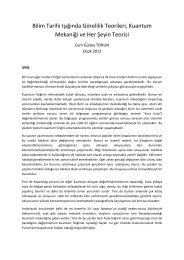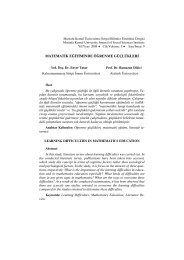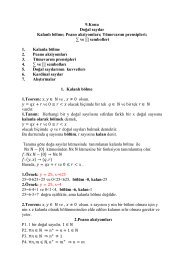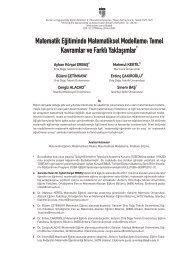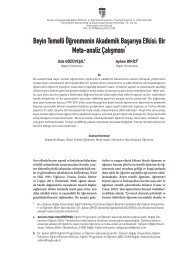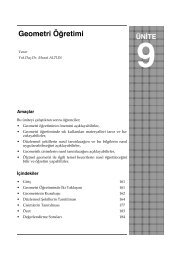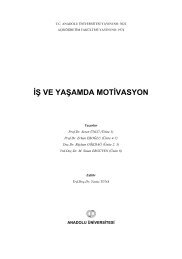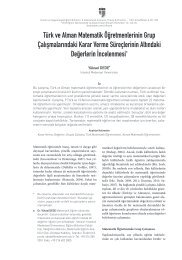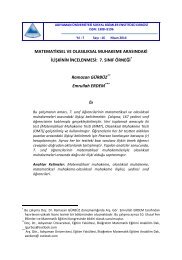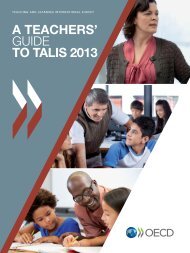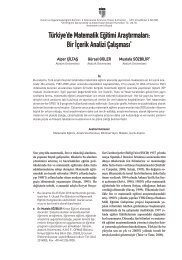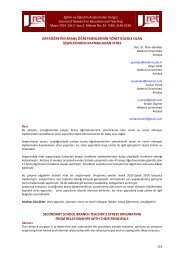inclusion of instructors who are not competent in the learner’s native language to the languageinstitutions and universities should be evaluated as this will increase the amount of languagepractice which might not be possible with instructors who are able to use learners’ nativelanguage.6. ConclusionThe present study investigated the language learning strategies of bilingual andmultilingual learners and the effect of instructor’s native language on the strategy use. 70participants took part in the study and the Strategy Inventory for Language Learning (SILL)developed by Oxford (1990) was used. The results indicated a main effect of the numberlanguages known on the language learning strategies which shows that multilingual learnersused the strategies remarkably more often than bilingual learners. The analyses also showedthat the memory strategies and the cognitive strategies were less frequently used by bilingualthan multilingual learners. Additionally, the bilingual learners indicated that they useconsiderably more affective strategies with an instructor who does not share their nativelanguage than with one who does. Due to the limitation of the institution, the results of thepresent study should be considered suggestive for further research regarding the effect ofmultilingualism and instructor’s native language on language learning strategies and foreignlanguage learning.70
ReferenceBhatia, T. K. (2004). Introduction. In T. K. Bhatia, & W. Ritchie (Eds.), The Handbook ofBilingualism (pp. 3-6). Malden MA, USA: Blackwell.Bialystok, E. (1986). Factors in the growth of linguistic awareness. Child Development, 57,498-510.Bloomfield, L. (1933). Language. London: Allen and Unwin.Butler, Y. G., & Hakuta, K. (2004). Bilingualism and Second Language Acquisition. In T. K.Bhatia, & W. Ritchie (Eds.), The Handbook of Bilingualism (pp. 114-145). MaldenMA, USA: Blackwell.Cambridge University Press. (2009). Placement Test. Retrieved November 18, 2012, fromhttp://www.cambridge.org/us/esl/venturesadulted/downloads/Ventures_PlacementTest.pdfCenoz, J. (2003). The additive effect of bilingualism on third language acquisition: A review.International Journal of Bilingualism, 7, 71-88.Cenoz, J., & Genesee, F. (1998). Beyond Bilingualism: Multilingualism and MultilingualEducation. Clevedon: Multilingual Matters.Cenoz, J., & Gorter, D. (2005). Introduction. Trilingualism and minority languages in Europe.International Journal of the Sociology of Language, 171, 1-5.Cenoz, J., & Gorter, D. (2011). Focus on Multilingualism: A Study of Trilingual Writing. TheModern Language Journal, 95, 356-369.Cenoz, J., & Jessner, U. (2000). English in Europe: The acquisition of a third language.Clevedon: Multilingual Matters.Cook, V. J. (2003). The changing L1 in the L2 user’s mind. In V. J. Cook (Eds.), Effects ofthe second language on the first (pp. 1-18). Clevedon: Multilingual Matters.Demirel, M. (2009). The validity and reliability study of Turkish version of strategy inventoryfor language learners. World Applied Sciences Journal, 7(6), 708-713.Demirli, C., & Türel, Y. K. (2012). Interactive Whiteboards in Higher Education: InstructorsFirst Impressions. Eurasian Journal of Educational Research, 49, 199-214.71
- Page 1 and 2:
ISSN: 2146-7676UFUK ÜNİVERSİTES
- Page 3 and 4:
UFUK ÜNİVERSİTESİSOSYAL BİLİM
- Page 5 and 6:
SUNUŞDergimizin 2014 yılı ilk sa
- Page 7 and 8:
A NEED-BASED EVALUATIONOF A PREPARA
- Page 9 and 10:
In the literature on language teach
- Page 11 and 12:
focus teaching on this. Accordingly
- Page 13:
International Relations) were 20 (7
- Page 16 and 17:
questionnaire in their English-medi
- Page 18 and 19:
REFERENCESAlagözlü, N. K. (1984).
- Page 20 and 21: APPENDIX A1 STUDENT QUESTIONNAIRE
- Page 23 and 24: 24. Converting short notes into
- Page 27 and 28: The Role Of Gender On University St
- Page 29 and 30: (Johnson 2001; Türküm, 2005). Joh
- Page 31 and 32: Table 1 : Means and Standard Deviat
- Page 33 and 34: 2.3 ProcedureEthical permission to
- Page 35 and 36: age and attitude toward help seekin
- Page 37 and 38: Economics and Administrative Scienc
- Page 39 and 40: REFERENCESAddis, M. E., & Mahalik,
- Page 41 and 42: Koydemir-Özden, S. (2010). Self-as
- Page 43 and 44: LİSE ÖĞRENCİLERİNİN MESLEKİ
- Page 45 and 46: göre mesleki bakımdan daha önce
- Page 47 and 48: Araştırmanın amacıMesleki olgun
- Page 49 and 50: Tablo 1: Lise Öğrencilerinin Mesl
- Page 51 and 52: Lise öğrencilerinin karar verme s
- Page 53 and 54: KAYNAKÇA Acıbozlar, Ö. (2006). Y
- Page 55: Oğuz, Ö. (2008). Lise öğrencile
- Page 58 and 59: 1. IntroductionDifferent from the p
- Page 60 and 61: noteworthy to mention that multilin
- Page 62 and 63: The findings indicate that multilin
- Page 64 and 65: Table 1. Descriptives statistics fo
- Page 66 and 67: overall six factor structure which
- Page 68 and 69: wider variety of strategies with a
- Page 72 and 73: Gardner, R. C., & MacIntyre, P. D.
- Page 74 and 75: AppendicesAppendix A- English Profi
- Page 77 and 78: ELT Student Teachers’ Evaluations
- Page 79 and 80: Reflective Teaching in TurkeyIn Tur
- Page 81 and 82: Table 1: Reliability Analysis o
- Page 83 and 84: Table 4: Mean and standard dev
- Page 85 and 86: Table 9: Mean and standard dev
- Page 87 and 88: ReferencesAkbari, R. (2007). Reflec
- Page 89: Pollard, A. & Triggs, P. (1997) Ref
- Page 92 and 93: 1. GİRİŞEğitim ve program geli
- Page 94 and 95: Genelgeçer tek bir bilimsel sürec
- Page 96 and 97: Program geliştirmedeki yenilikleri
- Page 98 and 99: -Elde ettiği sonuçlardan hareket
- Page 100 and 101: “İnternet Üzerinden Öğrenme
- Page 102 and 103: de sınıf içi dersler de öğrenm
- Page 104 and 105: teknik ve pedagojik uzmanlar gerekt
- Page 106 and 107: 3. Proje ekibinin kurulması4. Plan
- Page 108 and 109: KAYNAKÇABigdoli, H. (2004). The In
- Page 110 and 111: 110
- Page 112 and 113: Hiçbir öğrenci bir diğeriyle ay
- Page 114 and 115: İçerik sınıfta nelerin öğreti
- Page 116 and 117: (MEB, 2006; Tomlinson, 2005). Ek ol
- Page 118 and 119: - Öğrencilerden gereksinim duyduk
- Page 120 and 121:
desteklerine gereksinim duydukları
- Page 122 and 123:
KAYNAKÇAAlberto P. A, ve Troutman
- Page 124 and 125:
124
- Page 126 and 127:
1.GİRİŞBuradaki araştırma OECD
- Page 128 and 129:
öğretilenleri almışlar mı diye
- Page 130 and 131:
edileceğini araştırmaz, ancak bu
- Page 132 and 133:
yaşarlar: Çok fazla sayıda koşu
- Page 134 and 135:
• Birincil Stratejiler ve Destek
- Page 136 and 137:
ir dönemdir. Özellikle artan yaş
- Page 138 and 139:
2. Hipotez: Öğretmenlerin coğraf
- Page 140 and 141:
Tablo 7 Öğretmenlerin Coğrafi
- Page 142 and 143:
stratejileri”ne yönelik bilişse
- Page 144 and 145:
sonuçları χ 2 (12, N =407) = 13,
- Page 146 and 147:
sebebiyet verir. Bunun önemli bir
- Page 148 and 149:
KAYNAKÇAArtelt, C., Stanat, P., Sc
- Page 150 and 151:
Lieteratur. 10. Sonderheft: Lesesoz
- Page 152 and 153:
YAYIM ALANI, YAZIM KURALLARI ve YAZ
- Page 154:
• Birebir alımlar “…” İş





